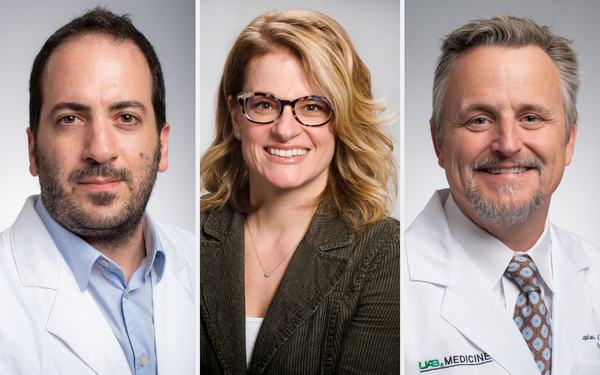 From left, Massimo Fazio along with co-investigators Alecia Gross and Christopher Girkinby Hannah Buckelew
From left, Massimo Fazio along with co-investigators Alecia Gross and Christopher Girkinby Hannah Buckelew
Massimo Fazio, Ph.D., an associate professor in both UAB’s Departments of Biomedical Engineering (BME) and Ophthalmology and Visual Sciences, together with Christopher Girkin, M.D., and Alecia Gross, Ph.D., received a five-year, $2.9 million R01 to support his project, “The mechanotranscriptome of the optic nerve head following acute experimental ocular hypertension in living human eyes.” The grant is funded by the National Eye Institute of the National Institutes of Health.
Glaucoma is one of the leading causes of irreversible blindness, for which the lowering of intraocular pressure (IOP) is the only proven treatment. Previous studies have been conducted with animal models to study the cellular, vascular and electrophysiological responses of the retina to acute IOP elevation and have provided insightful results about the relationship between retinal function and ocular perfusion (the passage of blood through the blood vessels in the eye). However, there are significant differences in optic nerve structure and composition across species, limiting the translation of these findings in the human disease.
The project will study the impact of IOP elevation in the living human eye for the first time by collaborating with Legacy of Hope, Alabama’s Organ and Tissue Donation Alliance, and utilizing the unique resources developed by the Living Eye Project, a larger project established by Fazio and Girkin. This project provides experimental access to the human eye in vivo in research-consented brain-dead organ donors prior to organ procurement. Legacy of Hope provides access to the same eyes for ex vivo analysis of cellular and tissue responses.
“This research could be highly translational for the future of imaging standards in patients with glaucoma,” says Fazio.
Fazio and Girkin’s research teams believe that changes in the fluid pressure inside the eye lead to mechanical deformation of the retina and optic nerve, which are responsible for generating and transmitting visual stimuli to the brain. Excessive mechanical deformations lead to altered states of these delicate tissues, which, if sustained over time, translate into permanent neurological damage and visual loss.
These mechanosensitive pathways will be characterized using spatial transcriptomics for the first time in the human eye alongside immunohistochemistry and protein analysis. Fazio predicts that increased IOP will initiate a profibrotic inflammatory phenotype and transcriptomic alterations that join the connective tissue density within the LC and are associated with the IOP-induced deformation of the ONH measured in vivo.
“We have an unprecedented opportunity to measure structural and biomechanical parameters of the human ONH in vivo and perform ex vivo evaluation of the cellular mechanobiology of the same tissue,” says Fazio.
Fazio’s co-investigators in the study are Girkin, Professor, UAB Department of Ophthalmology and Visual Sciences, who serves as contact PI for the grant, and Gross, Professor, UAB Department of Neurobiology, who serves as MPI.
Defining the “mechanotranscriptome” in the human ONH will critically assess the translational value of animal models for studying mechanotransduction, the signal and biomechanical exchange generated by cells as a consequence of their sensing mechanical stimuli. This will define the human cellular and molecular mechanisms of ONG remodeling needed to guide the development of novel therapeutics designed to enhance the resilience of the ONH to pressure-related stress.
“This research will provide the first direct experimental link between ONH mechanical strain and the molecular and cellular responses of ONH tissues that drive remodeling,” says Fazio.